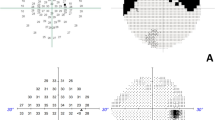Abstract
Fifteen children aged less than 11 years, affected by congenital glaucoma, underwent visual field testing using two different methods: conventional computerized perimetry (24-2 Humphrey program) and High Pass Resolution perimetry (Ring test). The aim of the study was to discover which of the two perimetric techniques was more suitable for younger patient. Results showed that HPR perimetry is more suitable to children. Reasons include the short duration of the test (5 min), and the appearance like a pleasant game to 80% of the subjects tested. In addition it proved to be better than Humphrey test because of the minimal possibilities of memorisation with a reproducibility factor of 68% in our sample and because of the reliable results and satisfactory evaluation in 76% of the eyes examined.
Similar content being viewed by others
References
Gandolfo E. Demotivation effect in automated perimetry. Minerva Ophthalmol 1990; 32, 2: 157–160.
Capris P, Gandolfo E, Zingirian M, Guidi C, Rizzardi E, Rovida S. Automated perimetry in children. Minerva Ophthalmol 1990; 32, 2: 161–164.
Wilson M, Quinn G, Dobson V, Breton M. Normative values for visual in 4 to 12-years-old children using kinetic perimetry. J Pediatr Ophthalmol Strabismus 1991; 28, 3: 151–154.
Frisen L. High pass resolution perimetry. A clinical review. Doc Ophthalmol 1993; 83, 1, 1–25.
Lindblom B. High-pass resolution perimetry: a new method for the early detection of visual field defects. Proc. Chibret Int. Symp. Innovation in ophthalmic research drug therapy and patient care, Copenaghen, February 1989. Chibret Int. J. Ophthalmol., 7, 1: 33–41, 1990.
Chauhan BC, House PH. Intratest variability in conventional and High-pass resolution perimetry. Ophthalmology 1991; 98, 1: 79–83.
Martin-Boglind LM, Wanger P. The influence of feedback devices, learning and cheating on the results of High-pass resolution perimetry.In: Heijl A. Perimetry update 1988/89. Proc 8th Int Perimetric Soc Meet, Vancouver, May 1988. Kugler & Ghedini Berkeley 1989; 393–398.
Frisen L, Nikolajeff F. Properties of High-pass resolution perimetry targets. Acta Ophthalmol 1993; 71, 3: 320–326.
Frisen L. A child's play version of high-pass resolution perimetry. Mills RP, Heijl A: Perimetry update 1990/1991. Ninth Int Visual Field Symp, Malmoe, Sweden, June 1990. Kugler, Ghedini, New York, 349, 1991.
Author information
Authors and Affiliations
Rights and permissions
About this article
Cite this article
Marraffa, M., Pucci, V., Marchini, G. et al. HPR perimetry and Humphrey perimetry in glaucomatous children. Doc Ophthalmol 89, 383–386 (1995). https://doi.org/10.1007/BF01203713
Accepted:
Issue Date:
DOI: https://doi.org/10.1007/BF01203713




